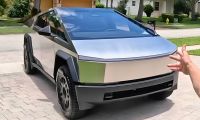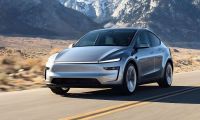Before any EV drivers start to reach for the tar and feathers, please hear me out. I would always give up my spot on a charger for an EV that needed access in order to get to their destination. In fact on the very day I was plugging in before my nosh with friends, a Nissan LEAF pulled into the parking lot a few stalls down from me and my Kia Sorento PHEV.
I walked over to the LEAF driver, waved and asked: “did you need to use the charger?” to which the driver replied “no”. I wanted to make sure I wasn’t taking up a resource the EV driver needed. I was proactively attempting to share. Plus, I have an adapter for Tesla destination chargers too and there were two of those not in use just a few stalls away that I could have used if the LEAF driver needed the J-1772 charger I was on.
The idea that purely electric cars should have priority over PHEVs comes from a standpoint of scarcity. More than 12 years after the beginning of the modern plug-in era, we still don’t have nearly enough public charging resources. It certainly makes sense that EVs need public charging options more than PHEVs do, but that logic should only be taken so far and it is important to clarify which type of public charging EVs really need (hint what they really need is 480V charging, more than 240V).
Here’s why I think we need to turn this idea on its head: public 240V charging is often, perhaps even usually, not being used by EV drivers as their primary means of charging up. That is what private, home based charging and or public 480V Level 3 “fast charging” is for. PHEVs mostly can’t use 480V chargers, and even when they can, given their smaller batteries, a higher output 240V charger can be almost useful topping off a PHEV as a 50kW 480V charger would be over a similar duration of 30-45 minutes (assuming the PHEV’s onboard charger can accept a higher kW supply). What’s more, recent studies keep calling PHEVs out for emitting more CO2 than they are supposed to.
Well, I might ask, when cities are banning PHEVs from using public 240V charging and experts are backing them up with their short sighted opinions, how in the heck are PHEVs supposed to achieve lower emissions if they can’t use the public 240V charging they were designed to be used with? They can’t, plain and simple, and this is why I say it is fundamentally wrong and egregiously irresponsible for anyone to suggest that PHEVs shouldn’t be allowed to use public 240V charging.
No, in fact I would go so far as to say that 240V charging is really better prioritized (but not reserved) for PHEVs. That is to say, since EV’s can use fast charging equipment more or less as easily as a PHEV can use a gas pump, unless it is a matter of needing just a little more charge to make it home, PHEVs should be given dibs at public 240V charging. Of course therein lies the rub… how does anyone know if that’s the case?
Well, not that it would be worth the trouble, but given that all modern plug-in vehicles have GPS and or smart phones attached to them, one possible way to handle this would be to allow charging stations and cars or mobile phones to communicate. An EV pulling in, running on sparks in need of just a 30 min 240V charge to make it home might “tell” the charger, which could then inform the driver of the vehicles on the charger, “hey, someone in more need is waiting on the charger, would you mind unplugging?”. Short of that, notes and leaving the plug unlocked can often do the trick too. “If you need the charger, it’s OK to unplug me!” is a note every PHEV driver should have at the ready.
But more needs to be done to get the balance right on all this. PHEVs need to be able to recharge faster than most tend to be able (3.7 kW at 16 amps is common, but that is too slow). High output from 240V stations would also benefit EVs and their use of these stations too, thus enabling better sharing of a limited resource. PHEVs also need to have a minimum range of at least 40 miles. Public 240V charging stations need to supply a minimum of 7.4kW too (and better still 11-19kW), and it would also just be helpful if automakers gave their PHEVs electric motors powerful enough to use only electricity through at least 75% of accelerator travel, if not 100% (like the Chevy Volt and a few other PHEVs could do).
What do you think, readers? Am I off base here? Please leave your thoughts and questions below.
Image courtesy of Justin Hart.
Justin Hart has owned and driven electric vehicles for over 15 years, including a first generation Nissan LEAF, second generation Chevy Volt, Tesla Model 3, an electric bicycle and most recently a Kia Sorento PHEV. He is also an avid SUP rider, poet, photographer and wine lover. He enjoys taking long EV and PHEV road trips to beautiful and serene places with the people he loves. Follow Justin on Twitter for daily KIA EV news coverage.













Comments
The BEV owner feeling of
Permalink
The BEV owner feeling of charging entitlement is so strong it will be hard to counter. Personally, I can't wait to park an Outlander PHEV at a Supercharger once they open to the public.
It truly is. I think until
Permalink
In reply to The BEV owner feeling of by John Goreham
It truly is. I think until chargers are no longer “scarce” that mentality will continue to be a challenge. Hopefully it doesn’t take too much longer for Tesla to open things up more (for their superchargers). I imagine they will only designate one or a couple super chargers per site to adapters/non Teslas, but that is fine I think. The change will be significant!
Justin "The other day I
Permalink
Justin "The other day I plugged in my Kia Sorento plug-in hybrid (PHEV) at a free, public 240V charging station while I met up with old friends over a bit of nosh."
Personally, I think there ought to be a law that PHEV or EV owners should be ticketed for "leaving" their vehicles at a charging station unattended. It really used to bug me to pull into a crowded gas station, and wait behind an unattended car, only to find out that the owner had filled his tank, went into the station, ate an attached restaurant and came out 20 minutes later, carrying his fast food drink while the rest of us waited for him to move his car. With the limited number of charging stations ... including "free" ones ... owners should stay in the cars and pull away when vehicle is charged to satisfy their current needs ... not go strolling away from the charging station to eat somewhere. I agree that both PHEV and EV owners should be allowed to use the limited number of chargers. Just stay with your vehicle ... and move it if someone waiting is in critical need of a quick charge ... and certainly move it when you have reached a sufficient charge.
But Tod, 240V charging takes
Permalink
But Tod, 240V charging takes hours so your expectation here is a little bit unrealistic. Also, there are apps for all these plug-in vehicles that tell you what state of charge your vehicle is at so any responsible driver would easily be able to get back to their car when their car is done/about to be done charging. In fact, this is what the majority of plug-in drivers do. Tesla has a great system in place for their chargers where people who are plugged in and not charging will get dinged extra $ on a per minute basis, all the while being warned by the app on their phones about what is going to happen or is happening. This is a much more realistic solution than expecting people to sit in their cars for a few hours on 240V charging, or even for 20 mins while stopped at a 480V “fast charger”.